Salesforce vs Zoho vs HubSpot vs Pipedrive vs Salesflare: what’s the best sales CRM for small businesses?
Un confronto strutturato delle principali alternative
Con oltre 800 CRM disponibili nel 2024, trovare il CRM giusto per la vostra piccola impresa può essere piuttosto scoraggiante.
You’re now comparing a few alternatives and might want to know which one will be best for you, without having to try each of them extensively.
Even though we’d recommend you to actually do that, we have gone through that pain on your behalf and have gone through trials of Salesforce, Zoho, HubSpot, Pipedrive and – of course – Salesflare.
We’ve structured each of the CRM reviews by criteria, so you can easily see how each CRM compares.
Additionally, we’ve added the honest review of a small business sales pro, who took the time to test 4 of the 5 covered CRMs actively in parallel for a week.
Here’s what we’ll cover
First off, we’ll have a look at each CRM alternative in detail:
- Informazioni su X: No good software comparison is possible without understanding the company offering this software. We’ll analyze the company, which customers they serve and why they do what they do.
- Esperienza dell'utente: If you’re a small business, user experience should be top of your requirements. What good is software if you’re not using it and getting practical benefits from it?
- Accessibilità mobile: Nel 2019 ci si aspetta di poter gestire la propria attività dal telefono. Anche se si passa la maggior parte della giornata al computer, a nessuno piace essere sempre legato ad esso.
- Capacità di automazione: Volete realizzare più vendite in meno tempo? Certo che sì, e un CRM può/deve aiutarvi. Il suo ruolo principale è quello di aiutarvi a organizzare e automatizzare il vostro lavoro di vendita.
- Prezzi: What money do you have to pay for all this value? As every app prices differently, we’ll take a dive into the pricing plans and how they actually compare.
- Supporto: Infine, cosa potete aspettarvi se avete bisogno di aiuto? Che tipo di assistenza potete aspettarvi, quanto velocemente vi risponderanno e quanto vi costerà?
After this we’ll briefly compare each set of CRMs separately:
- Salesforce vs Zoho
- Salesforce vs HubSpot
- Salesforce vs Pipedrive
- Salesforce vs Salesflare
- Zoho vs HubSpot
- Zoho vs Pipedrive
- Zoho vs Salesflare
- HubSpot vs Pipedrive
- HubSpot vs Salesflare
- Pipedrive vs Salesflare
Don’t want to read up on any details? Just click to your comparison of choice above. You can always get back to the details.
Don’t take only our word for it
However unbiased we tried to write this comparison, we wouldn’t expect you to base your decision only off what we believe makes the best sales CRM for small business.
That’s why we included a complete, honest and uncensored review of an independent party (now a happy Salesflare user) at the end of each CRM section.
Per prendere la decisione giusta per la sua azienda, Stephen Sexton, direttore delle partnership di NowADays Media, ha provato 4 diversi CRM in parallelo per una settimana.
Here’s the review he published after his grueling trial marathon:
A few weeks ago, I posted in a few groups on Facebook asking for advice on a CRM for a small agency I had just joined. I got some great feedback, but ultimately decided I’d have to figure it out myself. Based on feedback from the members of those groups, my final four were:
– Zoho
– HubSpot
– Pipedrive
– SalesflareAfter pouring through reviews, demo videos, free trials, and all the like, I decided the best way to make a decision was to test each CRM individually, simultaneously, and side-by-side. So, I set up and ran my sales ops on 4 different CRMs simultaneously for a week (you read that correctly), and yes it was a huge pain in the ass and a terrible idea to begin with. But hey – my pain is your gain.
Quick business context and shameless plug/ I recently joined an influencer marketing agency to establish and scale their outbound sales. We essentially fabricate social media virality for our clients. We create and run large-scale guerrilla social media influencer campaigns that create organic viral buzz about our clients. This typically snowballs into some pretty crazy ROAS for our clients. Message me if you’re curious about it. /shameless plug.
La sfida con il modello di business di cui sopra è che di solito lavoriamo con aziende grandi e complesse, che fanno campagne grandi e complesse, che abbiamo un ciclo di vendita lungo e complesso e che adottiamo un approccio piuttosto personalizzato alle vendite.
Il motivo per cui il nostro modello rende difficile la ricerca di un CRM è che la maggior parte dei CRM sembra rivolgersi alle vendite ad alto volume e ad alta velocità. Secondo la mia esperienza, la maggior parte dei CRM sviluppa i propri strumenti pensando alle aziende di tipo SaaS.
Tenendo conto di tutto ciò, ecco i risultati.
Read on at the end of each CRM section to learn more about Stephen’s verdict on that CRM.
È inoltre possibile analizzare questa ripartizione dei punteggi delle recensioni di centinaia di utenti su G2 per scoprire il punteggio di ciascun CRM in questo confronto (escluso Zoho; l'abbiamo lasciato fuori perché ha ottenuto un punteggio significativamente più basso rispetto agli altri 4 e abbiamo potuto selezionare solo 4 CRM nel confronto):
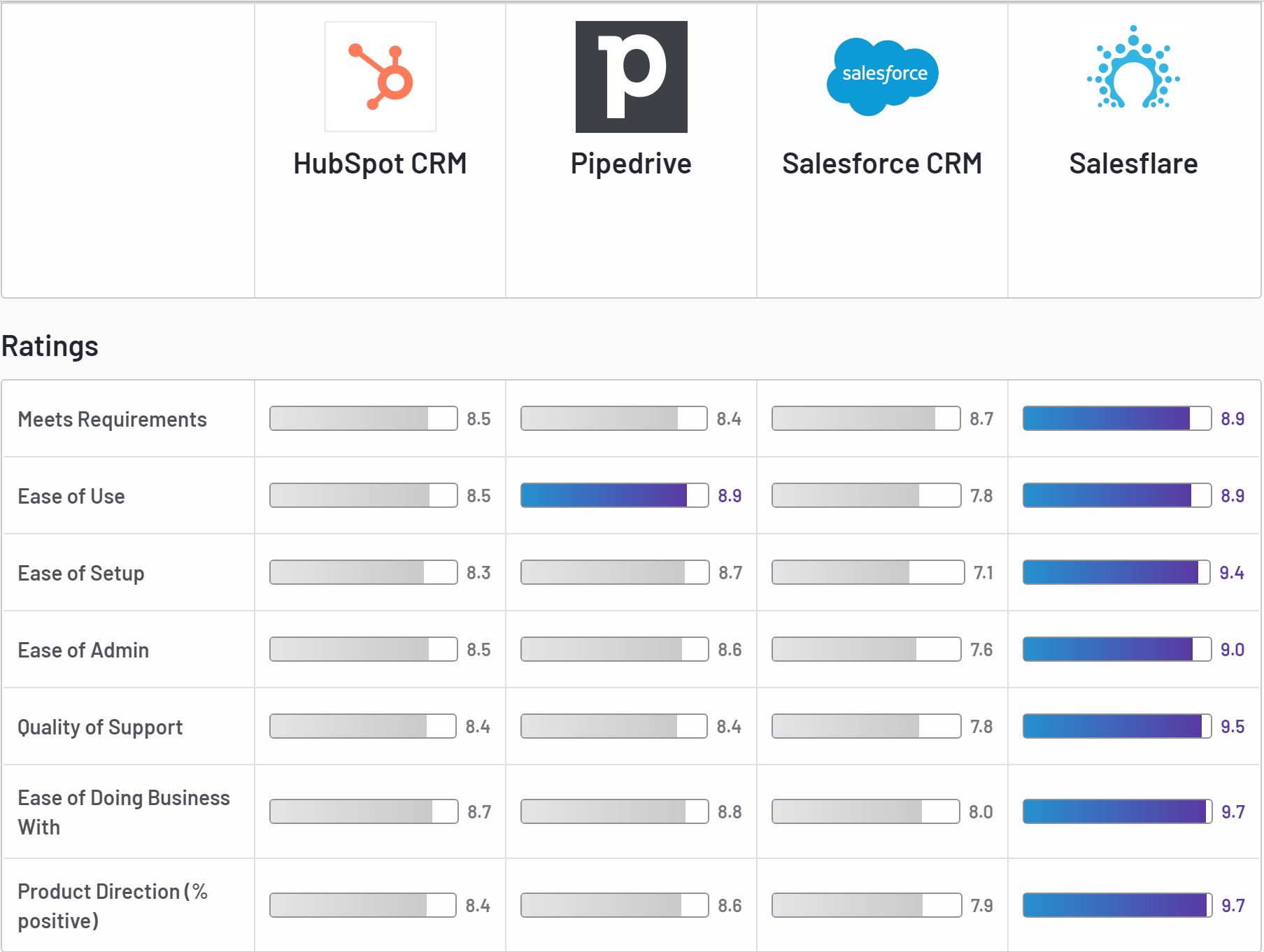
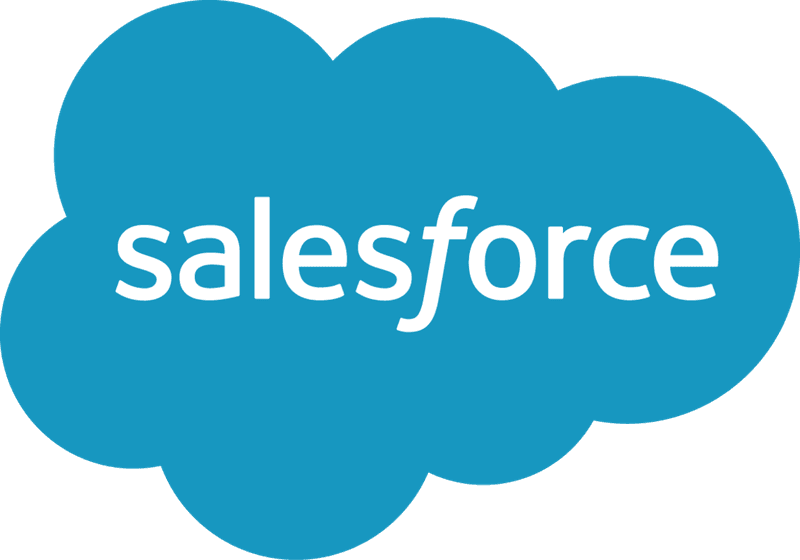
Salesforce
Informazioni su Salesforce
Salesforce è di gran lunga la più grande azienda CRM al mondo, controllando circa 19% del mercato nel 2019.
È stata fondata nel 1999 in California da un ex dirigente di Oracle.
Nei primi anni della sua esistenza, Salesforce si è concentrata sulle piccole imprese, aiutandole a portare nel cloud i loro vecchi database on-premise CRM.
Nel corso degli anni, tuttavia, la sua attenzione si è spostata principalmente sulle aziende più grandi, adattando il proprio software alle grandi imprese di questo mondo.
Nowadays, Salesforce offers a huge platform to enterprises that basically consists of a set of building blocks with which you can build anything, gives the possibility to customize everything, and the promise to connect to whatever other software you’re using.
Un'implementazione di Salesforce di solito richiede una società di consulenza per mappare le esigenze aziendali e il flusso di lavoro, costruire tutto questo in Salesforce, connettersi con altri software, formare i dipendenti e seguire le modifiche aggiuntive in seguito.
This doesn’t hold Salesforce back to also offer their software to small businesses in a version called Salesforce Essentials, which is essentially a limited version of the full platform.
Esperienza dell'utente
While around the year 2000 Salesforce’s user experience would be a revolution versus existing players, it had slowly traded its user experience for extreme customizability.
Nel 2015, Salesforce ha rinnovato la sua interfaccia utente per offrire ai suoi clienti una nuova e brillante Lightning Experience.
Un contatto nell'esperienza classica di Salesforce si presentava così:
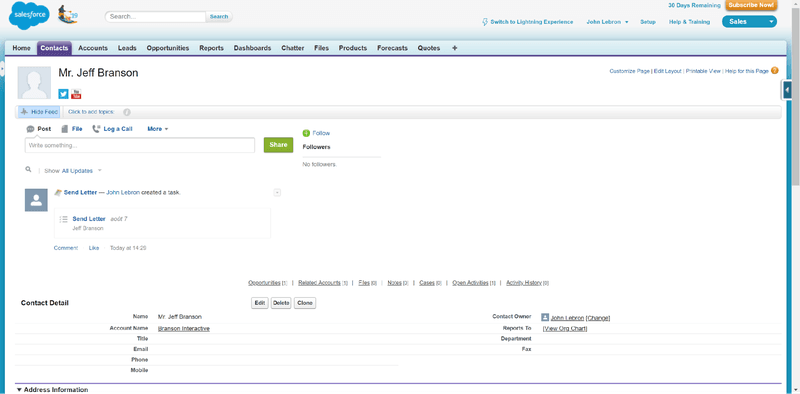
Dall'introduzione dell'esperienza Lightning, si presenta così:
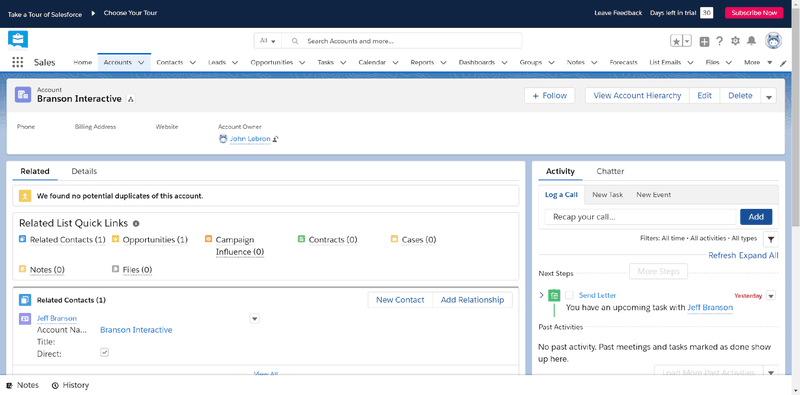
And here’s how an account looks:
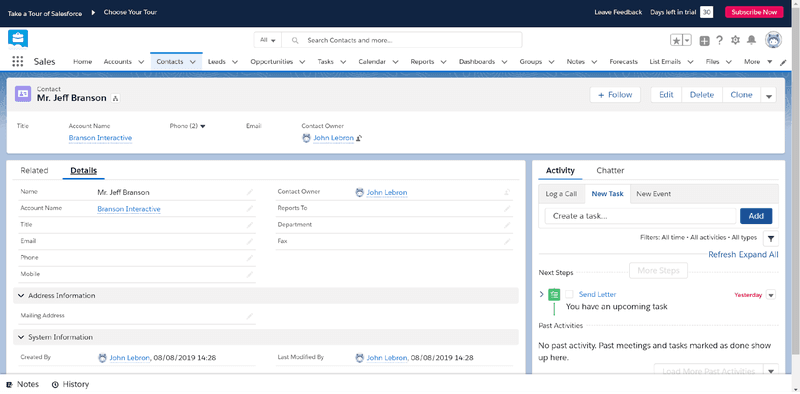
Sebbene il look and feel sia chiaramente cambiato, le basi e l'attenzione all'estrema personalizzazione sono rimaste al loro posto.
Le schermate sono costituite da una serie di blocchi in cui si trovano altri blocchi, schede e collegamenti ad altre schermate.
This is of course inherent to Salesforce’s extreme customizability. You can’t both have generic and adaptable screens… and also provide a seamless and pragmatic user experience.
It’s always important to keep in mind that Salesforce prioritizes the needs of (usually larger) organizations over the needs of its end users.
Tuttavia, rispetto ai CRM aziendali concorrenti di SAP, Microsoft e Oracle, offre ancora una delle esperienze più moderne.
Accessibilità mobile
Salesforce offre un'applicazione semplificata applicazione mobile, che ha un design simile alla sua Lightning Experience mostrata sopra.

Consente di eseguire azioni di base su contatti, account e opportunità, tra cui la modifica, l'eliminazione, la creazione di un'attività, la registrazione di una chiamata e altro ancora.
L'invio di e-mail agli elenchi, la modifica delle impostazioni, la creazione di rapporti e così via non sono possibili dall'applicazione mobile. Per queste operazioni si dipende sempre dal computer portatile.
Il menu di navigazione con le cose a cui si può accedere è comunque piuttosto lungo (circa 2,5 schermate su un telefono più grande).
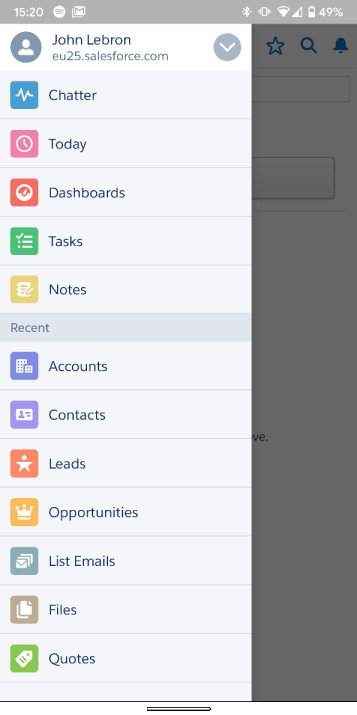
Capacità di automazione
Le possibilità in termini di automazione con Salesforce sono infinite: dall'automazione dei flussi di lavoro e dei processi di approvazione all'interno di Sales Cloud, alle campagne di vendita automatizzate con Salesforce Engage, all'automazione del marketing con Pardot, alle chiamate automatizzate con Salesforce Lightning Dialer, fino all'automazione delle vendite outbound con High Velocity Sales.
You will probably need a consultant to come in to set it up for you and a trainer to get your sales team up and running, but whatever you need, it’s there. And if it isn’t, you can still search for the right software in the Salesforce AppExchange.
Si noti tuttavia che tutti gli strumenti di automazione sopra citati hanno un prezzo aggiuntivo rispetto al piano Sales Cloud scelto ($25-$300 per utente al mese). Per darvi un'idea: High Velocity Sales vi costerà $75 al mese per utente e Pardot da $1.250 al mese (per le funzionalità di base e fino a 10k contatti).
Prezzi
Come appena detto, un piano su Salesforce Sales Cloud costa da $25 a $300 per utente al mese, a seconda delle funzionalità.
Connecting to Salesforce’s API is for instance possible from the Enterprise plan at $150 per user per month, or on the Professional plan if you pay an extra $25 on top of its $75 per user per month.
Depending on what features you need on top of Sales Cloud (like the automation features) or next to Sales Cloud, the package you’ll have to go with may be different.
It’s frankly hard to summarize and we therefore have to refer you to Salesforce’s very own pricing wizard.
Supporto
Come per le funzioni di automazione, il livello di assistenza dipende in larga misura da quanto si è disposti a pagare.
Salesforce’s pricing pages are not very clear about this topic. What is clear is that “24/7 Support and Configuration Services” only come on Salesforce Sales Cloud’s Unlimited Plan, at $300 per user per month.
The standard support on the lower plans is online support during weekdays and has a response time of 2 days. For additional and quicker support, you can buy one of the 3 support packages, starting at “20% net”. More info on the Success Plans pricing page.
Come la mette uno dei nostri utenti
Stephen Sexton, direttore delle partnership di NowADays Media, ha provato Zoho, HubSpot, Pipedrive e Salesflare in parallelo per una settimana, ma non ha preso in considerazione Salesforce nel suo confronto.
He shortly explains why he didn’t include Salesforce in his comparison:
It didn’t fit our use case. Salesforce has a super robust offering, but it’s not well equipped to satisfy a small team. It’s way too overpowered and overpriced for what we need.

Zoho
Informazioni su Zoho
Zoho Corporation è una società indiana di sviluppo software.
It’s the oldest company in this comparison, as it was founded in 1996 by Sridhar Vembu (owning 88% of the stock with his family) along with two siblings and three friends.
Ha lanciato Zoho CRM solo nel 2005, seguito da una vasta serie di applicazioni, come Projects, Creator, Sheet, Docs, Meeting e molte altre.
Zoho produce praticamente di tutto, dal software di contabilità ai bug tracker e alle soluzioni per le risorse umane, fino a una suite per la gestione dei dispositivi mobili. Se ne parla, loro lo fanno.
Nello spazio CRM, Zoho si è storicamente posizionata come alternativa più economica a Salesforce.
Come Salesforce, la sua attenzione principale è rivolta alle grandi imprese e il suo principale flusso di ricavi proviene da queste ultime.
Proprio come nel caso di Salesforce, potete farvi assistere da partner e formatori per l'integrazione dei sistemi, che vi forniranno la consulenza necessaria per mettervi al passo con i tempi.
Tuttavia, l'azienda si rivolge anche alle startup e alle piccole imprese con Zoho One, un pacchetto che promette di offrire tutte le app necessarie in un unico posto.
You can either sign up to this, or Zoho CRM, or Zoho CRM Plus. For the purpose of this comparison, we’ll focus on Zoho CRM, which is the most comparable software compared to the other sales CRMs in terms of functionality and price levels.
Esperienza dell'utente
Zoho’s interface has changed a lot over the years. Its latest design has a dark navigation bar at the top and a classic white-grey interface below.
The navigation bar contains more tabs than we’ve ever seen on a navigation bar. And when you think you’ve seen it all: most of the tabs have been hidden behind the 3 dot menu.
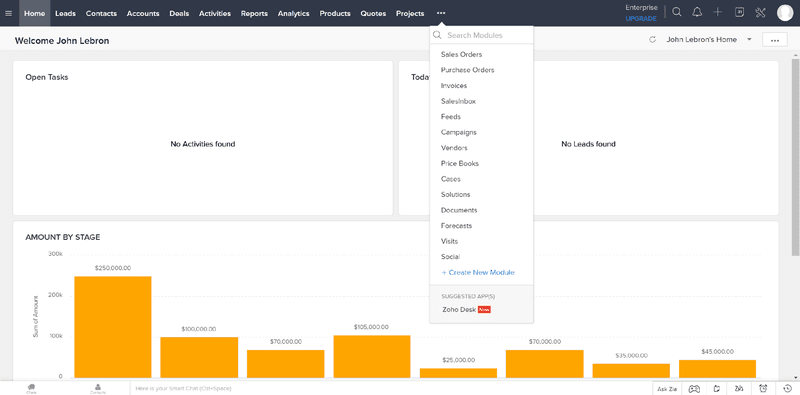
Adding the 7 buttons at the top right and 9 more in the additional bar at the bottom, there’s a whole lot to explore and navigate through.
The sheer amount of options seems to be what Zoho excels at. They won’t shy back from showing it to you.
When going to the Contacts page next, we’re greeted with a plethora of options yet again.

We land in canvas view and are immediately quite mind blown by the fact that we can create our own views. We don’t particularly enjoy the fact that it’s showing “n/a” everywhere, but that might just be us.
The accounts view has a similar look (with even more “n/a” mentions):
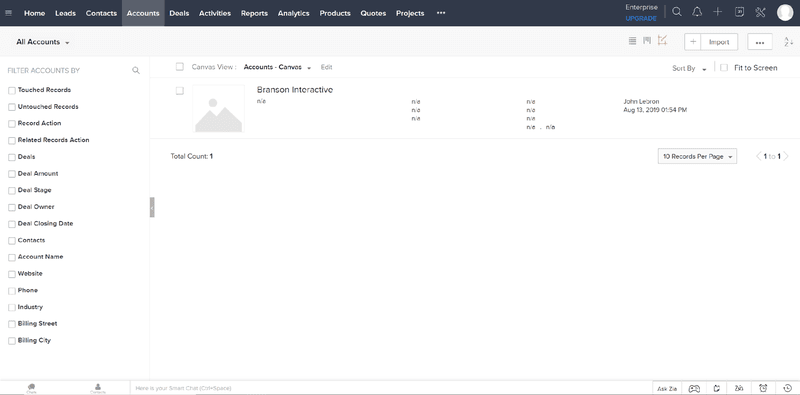
All'apertura del conto si presenta così:
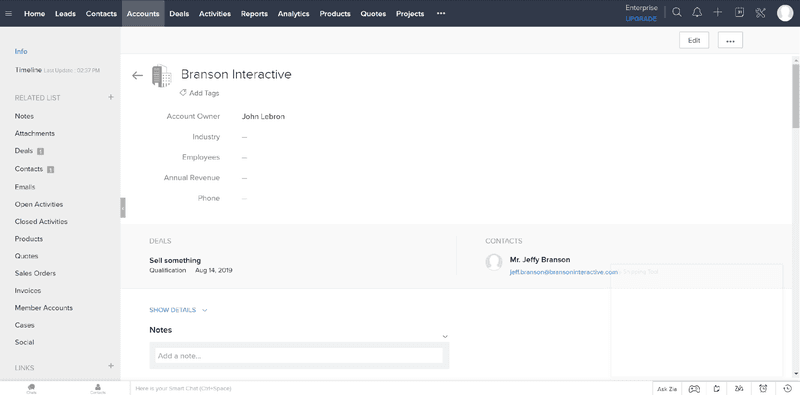
Come si può notare osservando la barra di scorrimento, si tratta di una lunga pagina che elenca tutte le entità potenzialmente collegate al conto, una sotto l'altra, raggruppate per tipo di entità.
It took us a moment to find out where the timeline was hidden, but we eventually found it in the newly introduced grey navigation menu on the left under “Timeline”. While all other buttons in this navigation menu make that you scroll to a certain place in the right part of the window, the “Timeline” button brings you to a new page.
Again, if you need something with a ton of configuration options and buttons, you probably will find the right partner in Zoho’s CRM. If we had to rank the CRMs in this comparison by ease of use (or by pleasure to use) however, Zoho would come in last.
Accessibilità mobile
Proprio come Salesforce, Zoho offre un'applicazione semplificata applicazione mobile. Rispetto a Salesforce, il suo design è piuttosto semplice.
Inoltre, presenta uno strano bug che mostra il colore rosa su ogni record e su tutta la navigazione. Purtroppo non siamo riusciti a risolverlo riavviando l'app o cambiando i temi, quindi abbiamo dovuto includerlo negli screenshot.
Here’s how the contacts look:
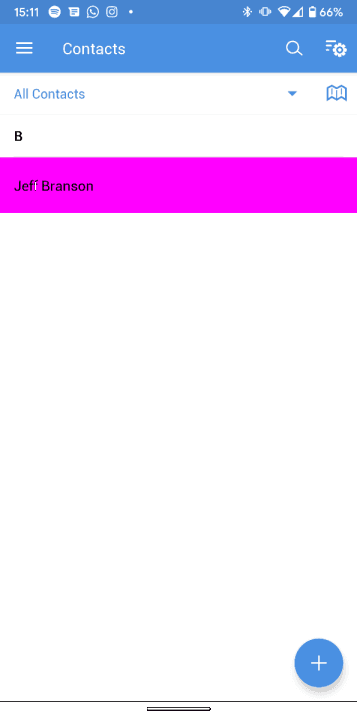
Quando si controlla questo contatto, si presenta così:
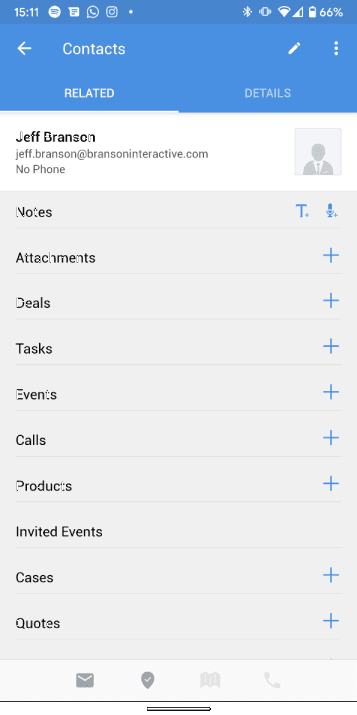
You can do all the basic operations from the mobile app, like creating, updating, deleting, … entities and also adding notes, attaching files, viewing reports, and more.
More advanced things like sending email campaigns or checking up on their results is not possible from the mobile app. Nor is creating reports, changing settings, making exports, …
This means you’re still dependent on your laptop when you’re on the move.
Capacità di automazione
Zoho è dotato di un'infinità di funzioni, che includono anche funzionalità di automazione.
It may become a bit overwhelming to research and understand what’s on which plan, so let us give you a quick overview of the main data automation and email automation features (at the time of writing):
- Mass emails start from the Standard plan, although the amount you can send depends on the plan you’re on
- La programmazione di queste email di massa parte dal piano Professional
- Il plugin per Outlook viene fornito dal piano Professional (non abbiamo trovato alcuna menzione di un plugin per Gmail nelle pagine dei prezzi, ma lo abbiamo trovato sul sito web della guida).
- La sincronizzazione di Google Calendar inizia con il piano Standard.
- La sincronizzazione della casella di posta elettronica parte dal piano Professionale
Prezzi
Come già detto, Zoho CRM è disponibile in diversi piani con livelli crescenti di funzionalità.
Assuming you’d like to get email sync, which is probably one of the main things you should expect from a good sales CRM, you’ll end up on the Professional plan, which costs $30 per user per month.
If you however would like enriched customer data like in Salesflare, you’ll immediately need to get on Zoho CRM’s Ultimate Edition, which will set you back $100 per user per month and is only available with an annual contract.
Don’t be surprised either if when subscribing you need to select an add-on to have your data backed up weekly (this confused us a lot: we thought that it was standard nowadays to always back up all data with point-in-time recovery, so you can restore it to the exact moment the database failed, without charging anything extra for this – apparently we were mistaken) for an extra $20 per month, or to get online training for $699 per user, or to get Premium support for $6 per user per month.
Supporto
If you’re as confused as we were when putting Zoho to the test, you’ll probably want to get support.
Zoho CRM comes with 4 different support tiers, depending on the kind of support you’d like to get.
If you don’t like paying extra on top of the subscription price, you get email, chat and phone support during weekdays with a response time of 8 hours.
Se si desidera ottenere un tempo di risposta inferiore a 3 ore, è necessario sottoscrivere un piano di assistenza Premium, che prevede l'aggiunta di 20% al costo della licenza. Tenete presente che questa opzione è disponibile solo se avete un contratto annuale.
Se avete più di 25 utenti, potete anche optare per un piano di assistenza Enterprise che riduce il tempo di attesa a 1 ora, ma poiché si tratta di un confronto tra CRM per piccole imprese, presumiamo che non ne avrete diritto.
Come la mette uno dei nostri utenti
Ecco come l'ha definita Stephen Sexton, direttore delle partnership di NowADays Media, dopo aver provato per un'intera settimana 4 diversi CRM in parallelo:
Zoho was easily the best value of the four. The CRM is functional and simple, and very easy to get started with. They demo the CRM with demo data, which gives you a great idea of how to set it up and use it. It’s a very robust system – it has everything that I could possibly need a CRM to do functionally.
The UI is alright, pretty similar to HubSpot. Nothing too special. Zoho does have an extremely comprehensive offering built into the CRM – including quotes, vendors, POs, invoicing, etc. I could see it being particularly useful to sole proprietors and freelancers. Very robust.
It features some sweet reporting and analytics dashboards that seem very comprehensive and customizable. It also offers some cool gamification capabilities for people managing a team. Zoho has an insane suite of integrated apps that could be useful down the road, as well as many key integrations with 3rd party apps, and their own app marketplace – lots of good stuff, especially for specialized businesses. The price point is cake at $12 for a standard subscription, but in all honesty, I would plop down the $30 for Zoho One and get the full suite of apps. Their Google Workspace integration was pretty seamless and robust as well – a major plus for my company.
Where Zoho fell short for me was in pipeline management. The activity and deal views are straight up ass. Even when switched to Kanban, they both look awful and cluttered. I had this same issue with the UI for contacts, leads and accounts. It just looks messy and the navigation was slow for me. This little rub seemed to keep popping up – the user interface feels difficult, unintuitive, and cluttered. With a few weeks or months of practice and usage, I’m sure I could make it work powerfully, but it just felt…. meh. Workflow automation is limited to a pro plan as well, so I couldn’t simplify my process much.
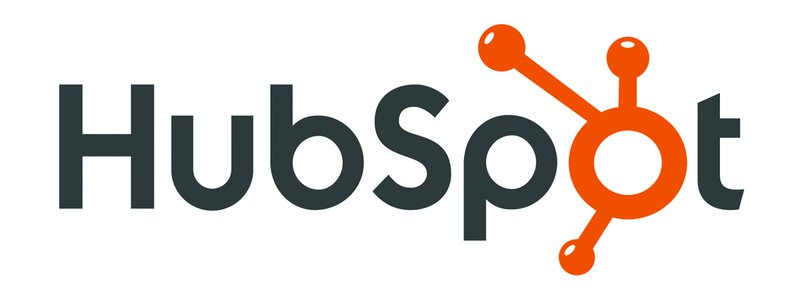
HubSpot
Informazioni su HubSpot
HubSpot è stata fondata nel 2005 a Boston da Brian Halligan e Dharmesh Shah. Prima di HubSpot, entrambi erano attivi principalmente nell'industria del software per computer; Halligan, ad esempio, era vicepresidente delle vendite per il prodotto oggi noto come Microsoft SharePoint Workspace.
HubSpot è nata come azienda di automazione del marketing e si è concentrata solo su questo per circa un decennio, fino a quando ha lanciato la sua piattaforma di CRM e di vendita alla fine del 2014.
Sebbene HubSpot si sia storicamente concentrata sulle medie imprese, dopo la sua IPO ha fatto irruzione anche nelle aziende più piccole e nelle imprese, lavorando sia su un modello freemium sia su un approccio di vendita aziendale per catturare parte di questi mercati.
Il suo obiettivo è fornire una suite CRM più facile da implementare ai clienti non aziendali. Questa suite è costituita da una serie di pacchetti, che a loro volta hanno diversi piani tariffari con diversi livelli di funzionalità.
When comparing HubSpot to directly competing CRMs like Salesflare and Pipedrive, we have to consider that what’s normally offered in one package, is split up between two different packages in the free CRM and the paid Sales Hub: features like email tracking, email sequences, email scheduling, calling, multiple pipelines, … are only available when getting the Sales Hub next to the CRM.
This immediately answers the question: why is HubSpot CRM free and why aren’t others too? To properly compare with other CRMs, you need to take the paid Sales Hub into the comparison.
Esperienza dell'utente
In HubSpot, everything starts from the Sales Dashboard. Above it, there’s a big navigation menu containing all of the different packages in its suite. Things you didn’t buy access to are indicated with a lock.

Un tipico record di contatto ha questo aspetto, con i dettagli a sinistra, una linea temporale al centro e una serie di altri elementi correlati a destra.

L'aspetto di un record del conto è praticamente lo stesso:
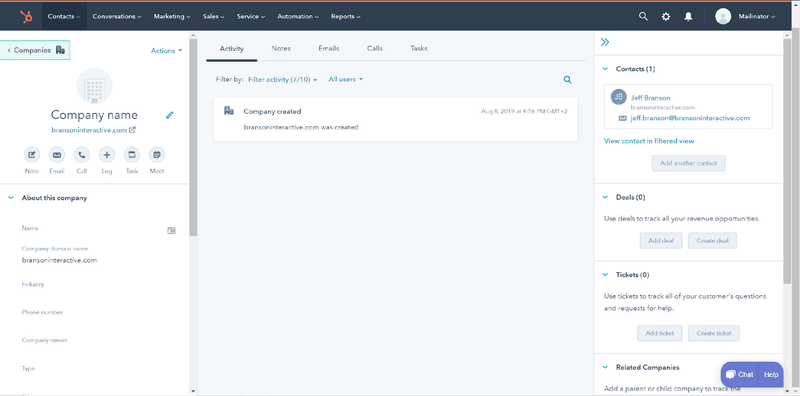
And lists of deals, contacts, accounts, tasks, … look like this:

Per passare da una schermata all'altra, ad esempio dai contatti agli affari o alle attività, è necessario conoscere bene l'ampio menu di navigazione e i suoi sottomenu, che a volte possono risultare scoraggianti.
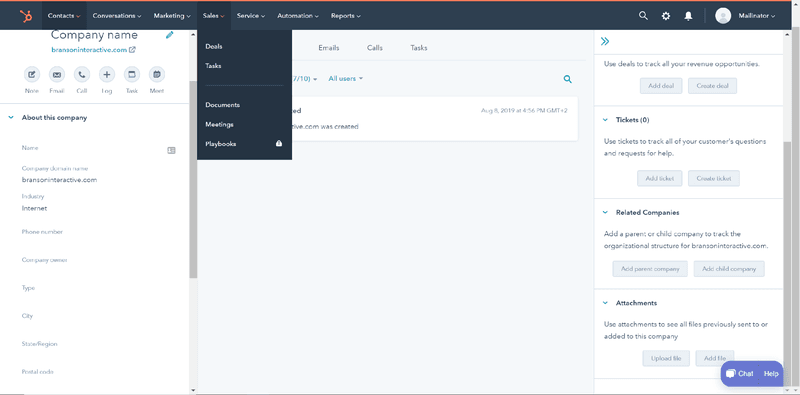
Creating entities, linking entities, attaching files, … works through a myriad of different mid-screen dialog windows or sidebars, like this one:
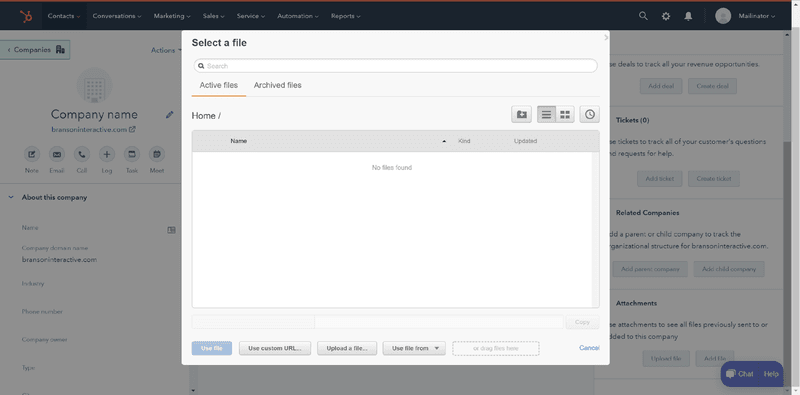
In general, we would say that HubSpot is rather straightforward to work with. If you are however looking for a lightweight experience, it might not be what you’re looking for.
Accessibilità mobile
HubSpot offre un'applicazione applicazione mobile molto semplificata, che consente azioni di base su contatti, aziende, offerte e attività.
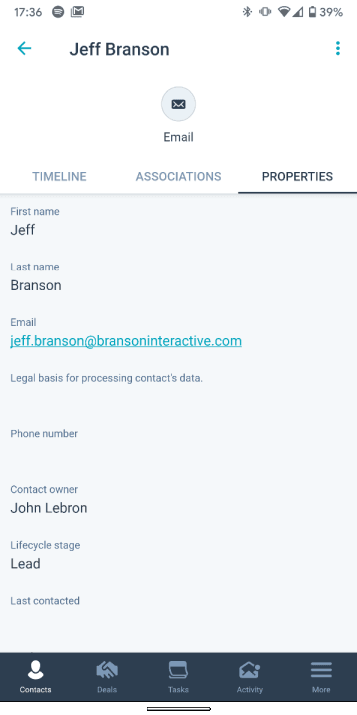
You however can’t view reports, track or create email sequences, upload files, …
This means you’re dependent on your computer for many of the things you would expect to do from your phone in this day and age.
Capacità di automazione
HubSpot has always offered quite some automation features, like email sequences, task automation, predictive lead scoring, …
Here’s for instance how the email sequences look:

HubSpot è in attività da tempo e la maggior parte delle sue funzioni di automazione sono ben implementate.
La maggior parte di queste funzioni, se non quasi tutte, sono tuttavia disponibili solo nei piani superiori.
Il che ci porta immediatamente al punto successivo:
Prezzi
As mentioned in the introduction “About HubSpot”, when comparing HubSpot to competing CRMs like Salesflare and Pipedrive, we have to consider that what’s normally offered in one package, is split up between the free CRM and the paid Sales Hub: features like email tracking, email sequences, email scheduling, calling, multiple pipelines, … are only available when getting the Sales Hub next to the CRM.
Per iniziare con il piano Starter più semplice, Sales Hub, HubSpot vi costerà $50 per utente al mese.
Se si desidera utilizzare le funzionalità di automazione di cui sopra, come l'automazione delle attività, o se si desidera rendere i campi obbligatori o utilizzare l'integrazione con Slack, è necessario ottenere il piano Professional che parte da $400 al mese ($80 per utente al mese con un minimo di 5 utenti).
Per le quote o il lead scoring è necessario un piano Enterprise, a partire da $1200 al mese ($120 per utente al mese con un minimo di 10 utenti).
Supporto
Il CRM gratuito viene fornito solo con il supporto della comunità, il che significa che avete accesso solo ai forum per risolvere le vostre domande. E alle vendite per le domande sulle vendite.
Nel caso di CRM + Sales Hub, l'assistenza via e-mail è disponibile come nel piano Starter. Se si desidera anche l'assistenza telefonica, è necessario un piano Professional o Enterprise. I prezzi sono quelli indicati sopra.
Come la mette uno dei nostri utenti
Ecco come l'ha definita Stephen Sexton, direttore delle partnership di NowADays Media, dopo aver provato per un'intera settimana 4 diversi CRM in parallelo:
HubSpot also happens to be a solid value, mostly because it’s free. I received a lot of recommendations for the HubSpot CRM, but after using it for a week, I couldn’t understand why anyone would recommend it, other than the fact that it’s free. The UI suffers from many of the same issues as Zoho, but with a much less robust offering and suite of apps to compensate.
C'erano però alcuni lati positivi: l'interfaccia utente era leggermente più pulita e meno ingombra di Zoho. Inoltre, ha una casella di posta integrata nella piattaforma, il che significa meno schede aperte e (di solito) una migliore integrazione delle e-mail. L'automazione del flusso di lavoro è purtroppo una funzione a pagamento, così come il sequenziamento delle e-mail.
One annoyance I had was that the CRM dashboard also has tabs for Customer Service and Marketing permanently attached and intermingled into the home bar, instead of only having sales-related tabs. You have to click the “sales” dropdown to find deal and activity views. Seems dumb. This immediately meant more clicking to find what I need. The deals view was much cleaner than Zoho however, as was the tasks/activities view. The Gmail integration was tight, and the free HubSpot Chrome extension was immediately helpful.
The thing I appreciated most from HubSpot was the cleaner UI, lots of open space while navigating so you don’t feel claustrophobic, and its ease of use and setup
Overall however, HubSpot seemed like a great choice for companies/users where sales is ONE of the primary focuses, not THE focus. It didn’t feel like it was truly developed to make salespeople happy and make their jobs easier – it felt like it was developed to get people using a HubSpot product before pushing them to new HubSpot products.
As a sales professional, that bugged me enough to pass on the good ol’ free CRM.

Pipedrive
Informazioni su Pipedrive
Nel 2010 Pipedrive è stata fondata da due soci di una società di formazione e consulenza, Timo Rein e Urmas Purde, che erano stufi dei CRM aziendali costruiti per le organizzazioni e i manager, piuttosto che per gli utenti finali (cfr. la nostra recensione di Salesforce qui sopra).
Si sono uniti a tre sviluppatori che, insieme a loro, formano il team co-fondatore di Pipedrive, composto da 5 persone.
Fino al 2016, Pipedrive ha venduto la sua semplice soluzione a prezzi stracciati e, in questo modo, è riuscita a competere con successo con CRM più grandi e complicati nel mercato delle piccole imprese.
Sotto la pressione competitiva di molte nuove aziende di software e per non rimanere troppo indietro in un mercato di soluzioni di vendita in rapida evoluzione, si sono concentrate sull'aggiunta di piani tariffari più elevati con maggiori funzionalità (dopo aver aumentato anche i prezzi originali).
Se per la maggior parte della sua esistenza Pipedrive si è concentrata sulle piccole imprese, negli ultimi tempi ha aggiunto le sue nuove funzionalità ai suoi piani più alti per entrare nelle aziende più grandi e aumentare il rendimento per i suoi investitori.
Quando si confronta Pipedrive con altri CRM, bisogna concentrarsi sul piano Advanced e lasciare fuori dal confronto il piano Essential.
Esperienza dell'utente
Pipedrive’s main and most popular screen has always been the sales pipeline:
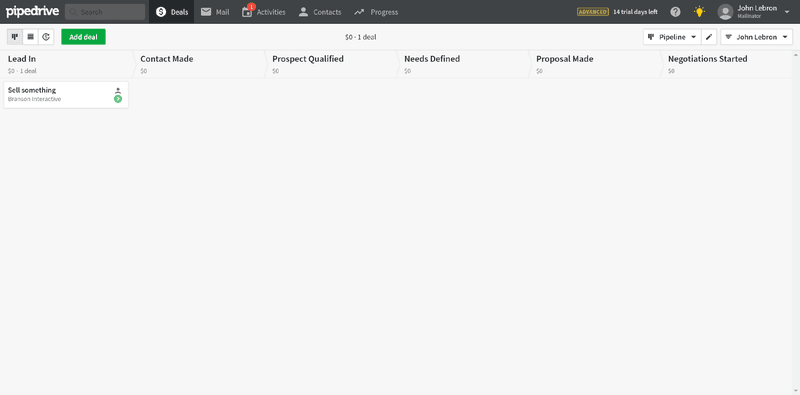
Sebbene Pipedrive non abbia certamente inventato le tavole Kanban, potrebbe aver contribuito a rendere popolare questo tipo di visualizzazione in un CRM, al punto che tutti i CRM di questa recensione presentano attualmente la stessa visualizzazione.
Wherever you click from here – to deals, contacts/people, or organizations – you’ll be met with a screen that has a bar on the top with a few buttons, a series of blocks with details on the left, and a timeline on the right.
This is how a contact/person (we’re not sure how to name at it, as they have “people” stacked below “contacts” in the navigation) screen looks:
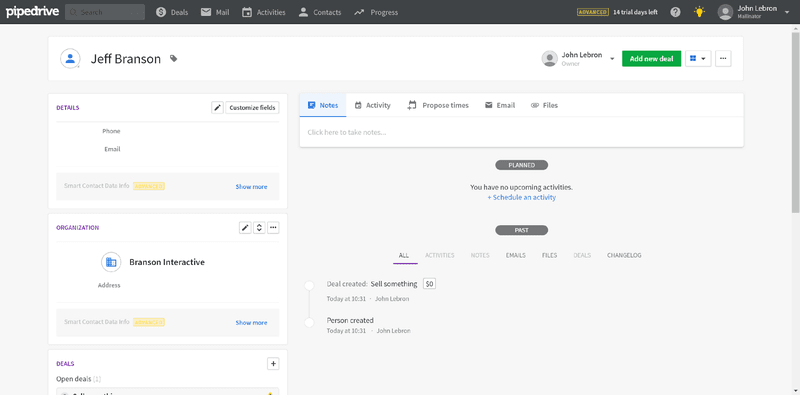
E questo è l'aspetto di un'organizzazione:

Tutti gli elenchi hanno un aspetto simile a quello di Excel:

Non male per chi sta migrando da Excel, ma nemmeno nulla di particolarmente stimolante.
The dashboard feature hiding behind “Progress” in the navigation looks like this:
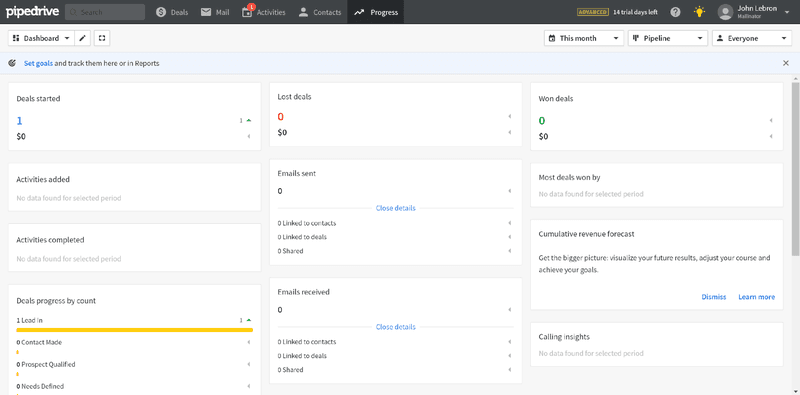
Tutto è abbastanza facile da trovare, a meno che non si debba modificare qualcosa nelle Impostazioni, che presentano una serie di schede in alto, una navigazione e delle sotto-navigazioni.
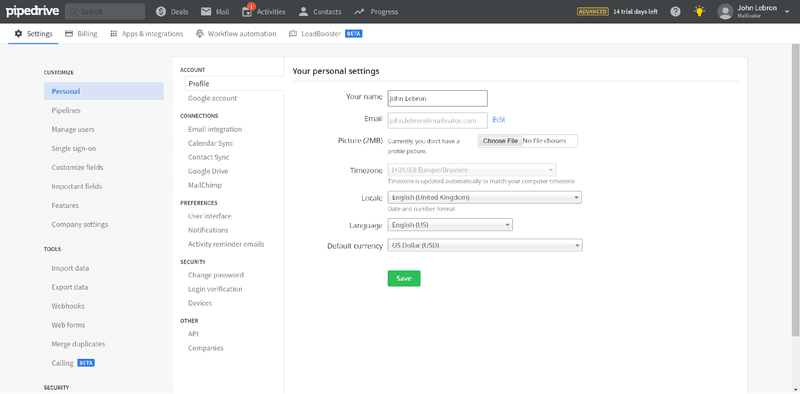
Overall, it’s a pretty simple system to use and set up for salespeople.
Its lay-out hasn’t changed much over the years, so what you see is what you get.
Accessibilità mobile
Proprio come HubSpot, Pipedrive offre un'applicazione applicazione mobile molto semplificata, che consente azioni di base su contatti/persone, organizzazioni, accordi e attività.

You can’t view reports, track or create email sequences, change any of the settings, get email activity notifications, …
This means you’re dependent on your computer for many of the things you would expect to do from your phone nowadays.
Capacità di automazione
While Pipedrive didn’t have any serious automation capabilities for a long time, they have recently been developing features to catch up.
While email integration and automation are now advertised as two main pillars of Pipedrive on the website, next to its sales pipeline view, we can’t help but admit that we often ask ourselves why Pipedrive isn’t putting in a more serious effort in these fields.
Sull'integrazione delle e-mail:
- La sincronizzazione delle e-mail con Gmail e Office 365 non è nativa e spesso è in ritardo rispetto alla situazione reale della casella di posta. Non è mai istantanea.
- Il modo in cui gestisce il tracciamento delle aperture e dei clic delle e-mail non è all'altezza della maggior parte delle soluzioni di tracciamento delle e-mail presenti sul mercato, comprese quelle gratuite.
- La barra laterale e-mail per Gmail mostra solo alcuni dati semplificati di Pipedrive. Al momento non è disponibile una barra laterale per Outlook.
Sull'automazione:
- Most of the customer data (the very basis of all automation) still has to be inputted manually. There’s very little intelligence going on.
- The main automation feature offered and advertised is workflow automation. It’s like a very basic Zapier or Integromat version within Pipedrive, without the cross-application appeal of these systems. It also doesn’t keep your contacts in sync.
As long as Pipedrive doesn’t work more on the main functionality it advertises on its homepage, it strikes us as very confusing messaging.
Prezzi
Pipedrive entra nel mercato con il suo piano di base a un prezzo molto basso, pari a $15 per utente al mese.
Tuttavia, il primo piano che inizia a essere competitivo con gli altri CRM in questo confronto è il piano Advanced, al prezzo di $29 per utente al mese.
If you’re interested to send mass email campaigns (called “email distribution lists” or “group emailing” in Pipedrive’s case) or do one-click calls, you need to get on its “recommended” Professional plan which will set you back $59 per user per month.
Supporto
Pipedrive pubblicizza un supporto 24/7 via chat o e-mail su tutti i piani.
When we tried their support (just once, obviously not a statistically relevant test), we first chatted for a while with their chatbot, after which we got the message that their support staff was over capacity. Pipedrive support was marked as “Away”.
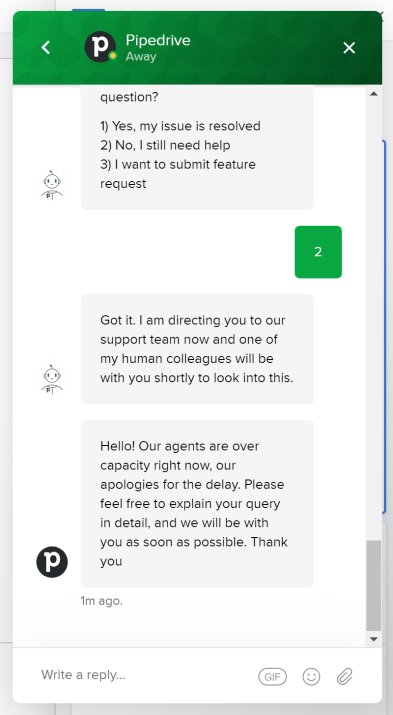
Con il piano Enterprise, al costo di $99 per utente al mese, è possibile ottenere assistenza telefonica e aiuto per la configurazione.
Come la mette uno dei nostri utenti
Ecco come l'ha definita Stephen Sexton, direttore delle partnership di NowADays Media, dopo aver provato per un'intera settimana 4 diversi CRM in parallelo:
This one was very tough. I initially started my search being pretty confident that Pipedrive would win. Pipedrive is a great product, and I had always suggested it to my sales leaders when working for bigger companies because of how easy it was to use, and how intuitive the design and functionality are. Initially, I started ONLY a Pipedrive trial because I was convinced it was all I needed. It wasn’t until I had used it for a few days that I identified a few major shortcomings that were difficult to overlook.
At a high level, Pipedrive does everything you need a CRM to do. It has many of the functionalities of the big dogs like Salesforce, but it’s way easier to use, way more intuitive, and less clunky. The customizability was pretty fantastic. It had an inbox built in. It had a Gmail integration, a full marketplace of apps, and prebuilt Zapier integration templates. It didn’t LOOK like a poor CRM used as biz dev for other apps, like what Zoho and HubSpot felt like. It felt like it was built by salespeople to accomplish sales functions in a simple way.
The main view is a deal flow view, which I love. Importing data, updating deals, contacts and accounts, inputting activity… it was all very straightforward and simple. To me, Pipedrive took the best parts of Salesforce, and flushed the stuff that really sucks. It might sound like I’m a Pipedrive rep or something – if that’s the case, it’s because Pipedrive is THAT much of an improvement from most CRMs.
The decision ended up coming down to Pipedrive or Salesflare, and it was an extremely tough one. I really liked the company’s brand personality. It’s pro-sales, and pro-easy. If you google “promo codes for Pipedrive”, they even built a hidden page on their website that says “We like smart people who search for promo codes. Here you go.” It checked all the boxes and improved on all the gripes I had with HubSpot and Zoho.
Ciò che mi ha fatto inciampare su Pipedrive è stata l'integrazione con le e-mail. Anche se c'era un'integrazione a due vie, era stramba e se volevo fare qualsiasi tipo di tracciamento delle e-mail o dei link, dovevo inviare l'e-mail da Pipedrive. Non solo, ma non c'era alcun tipo di notifica sul desktop per le aperture delle e-mail, le risposte, i clic sui link, ecc.
The reason that sucks is that unless I have the Pipedrive app open at all times, I might miss a hot lead who is clicking on my email/website. It also means if I had to respond to an email with my cell, that email wouldn’t get tracked at all. It ALSO meant I could no longer use Gmail as my guiding productivity tool – my life had to be run out of Pipedrive if I wanted it to be effective.
Oltre a questo aspetto negativo, è stato molto difficile ottenere assistenza da Pipedrive al di fuori della chat dal vivo. Non mi è mai stato offerto un rappresentante, mi è stato inviato un video di YouTube quando ho richiesto una demo e, in generale, ho avuto la sensazione di essere solo un piccolo pesce in un mare di altri clienti Pipedrive. Il che, ovviamente, è vero. Ma alla fine mi ha aiutato a prendere una decisione.
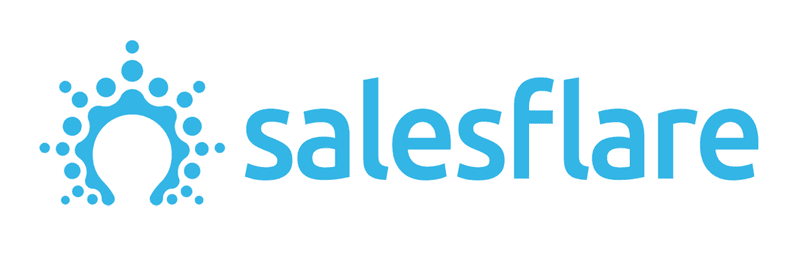
Salesflare
Informazioni su Salesflare
Nel 2014, Salesflare è stata fondata da Jeroen Corthout e Lieven Janssen, dopo la frustrazione per i diversi strumenti CRM che cercavano di utilizzare per la loro azienda di software di business intelligence.
Ispirati sia dalla scarsa esperienza d'uso dei sistemi CRM aziendali sia dalla forte dipendenza dall'inserimento manuale dei dati nei CRM di vendita per le piccole imprese, hanno deciso di costruire un CRM super facile da usare che automatizzasse tutti i dati dei clienti.
Hanno capito che i dati che stavano tracciando nel loro CRM erano in realtà già disponibili in molti altri luoghi: potevano sincronizzare le e-mail e rilevare le firme delle e-mail, tracciare le aperture e i clic, leggere le firme delle e-mail, inserire le riunioni, rilevare automaticamente i nuovi contatti di vendita, integrare i dati sociali, arricchire i contatti e le aziende con informazioni disponibili pubblicamente e molto altro ancora.
Dall'inizio a oggi, Salesflare ha automatizzato e semplificato il CRM per le piccole imprese, dalle startup tecnologiche in rapida crescita alle agenzie di marketing.
Nonostante sia l'attore minore in questo confronto, l'Salesflare è utilizzato attivamente da migliaia di professionisti in oltre 60 paesi.
Essendo un attore più recente sul mercato, è stato in grado di adattarsi meglio alle esigenze moderne. Inoltre, raccoglie costantemente punteggi elevati sulle principali piattaforme di recensioni come G2Crowd, in tutte le diverse misure del prodotto, tra cui l'implementazione, la relazione, l'usabilità e il risultato complessivo.
Esperienza dell'utente
Quando si prova l'Salesflare per la prima volta, si viene accolti da un percorso interattivo che guida l'utente attraverso gli elementi essenziali in pochi minuti:
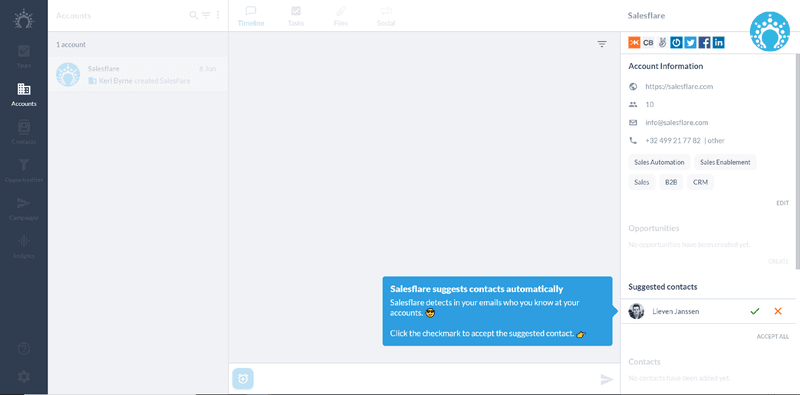
Alla fine di questo percorso, si arriva alla schermata della pipeline di vendita:
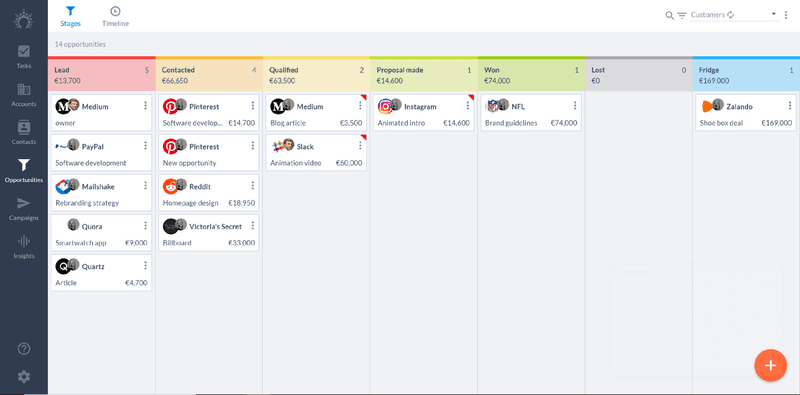
Every different screen in Salesflare has a custom lay-out, adapted to visualize the specific entity you’re looking at.
La schermata dei contatti si presenta così:
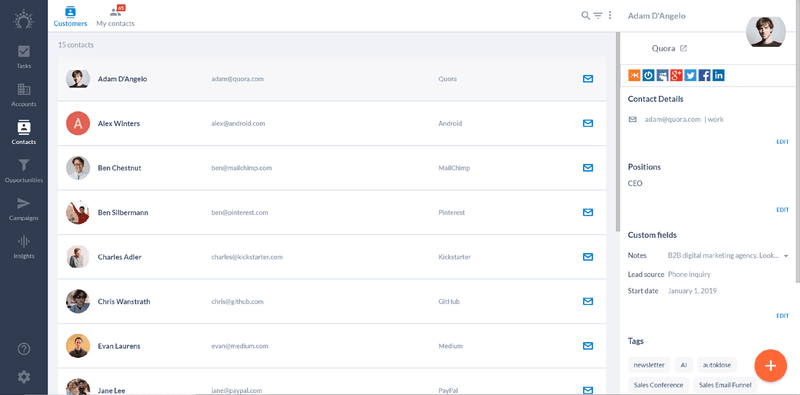
La schermata dei conti si presenta come segue:

E i compiti come questo:

Each screen is focused on its specific use. You never feel like you’re (still) working out of an Excel file.
La navigazione a sinistra fa sì che ogni schermata sia facile da trovare e a portata di clic.
Accessibilità mobile
A differenza di ogni altro CRM in questo confronto, l'Salesflare offre tutte le sue funzionalità su ogni dispositivo.
Whether you’re on your computer, your phone, your tablet, or even inside your email inbox with the email sidebar, all functionality is at your fingertips.
Volete inviare una campagna e-mail o verificarne i risultati? Nessun problema.
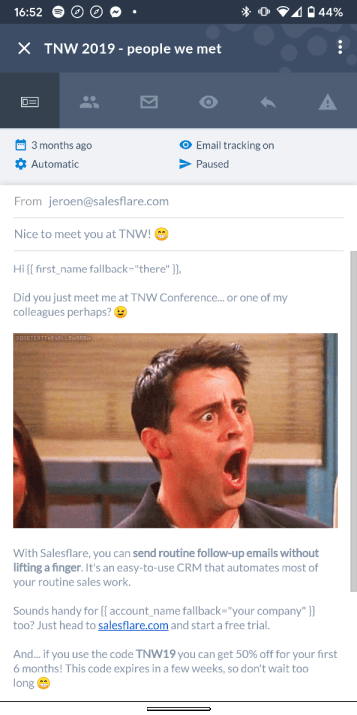
Il design è in gran parte coerente tra i vari dispositivi, il che rende il passaggio da un dispositivo all'altro un gioco da ragazzi.
Questo è ad esempio l'aspetto della pipeline delle opportunità sul vostro telefono:
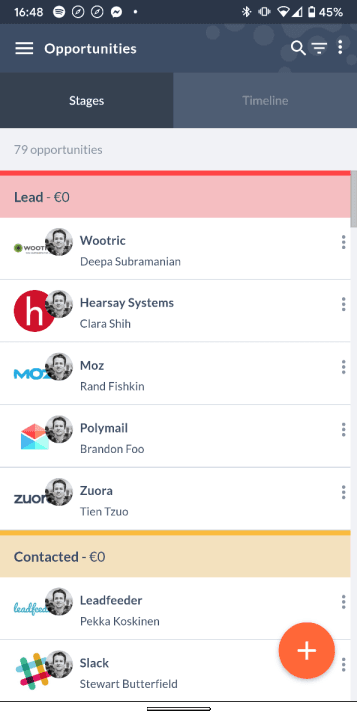
The mobile app can also keep you up to date on everything that happens with live push notifications: whether it’s a lead visiting your website live, a colleague sending a message about a customer, … you’ll never miss it.
Capacità di automazione
Mentre la maggior parte degli altri CRM offre l'automazione in aggiunta alla loro esperienza di base, l'automazione è la base stessa del funzionamento di Salesflare.
Tra le altre cose, Salesflare automaticamente:
- Crea i contatti che avete presso gli account potenziali e li propone
- Importa le firme delle e-mail e i dati sociali per i contatti e gli account.
- Reminds you to follow up accounts that go inactive, or to respond to emails you’re forgetting
- Keeps track of email opens, email clicks and website visits, whether you’re emailing from Gmail/Outlook, or from Salesflare’s desktop or mobile app
- Can send emails (and even email sequences!) when deals reach a certain stage, a contact gets a certain tag, an account becomes inactive, …
- Compiles timelines with all the touchpoints you had with customers from emails, meetings, calls, … even if those happened before you started using Salesflare or added the account
Salesflare’s email integration with Gmail and Office 365 is fully native and pulls in emails before you even know they hit your inbox, without fault.
Se si desidera automatizzare i dati e i flussi di lavoro tra le varie applicazioni, l'Salesflare si collega facilmente a Zapier, PieSync e Integromat.
Oltre a tutto il suo nucleo di dati automatizzati sui clienti, Salesflare continua a costruire ulteriori automatismi all'interno dell'applicazione, concentrandosi sempre sul fatto che tutta questa complessa automazione sia il più semplice possibile da usare.
Prezzi
Salesflare’s pricing (per user per month) is simple:
- Its Growth plan packs almost all of the features. It’s $35 on the monthly plan, or $29 on the annual plan.
- Its Pro plan takes it one level further with email sequences, permissions and custom dashboards. It’s $55 on the monthly plan, or $49 on the annual plan.
- Avete bisogno di assistenza a livello aziendale? Il piano Enterprise ha un costo di $99, solo annuale.
Questi piani sono assolutamente completi di tutto, senza sorprese. Ciò significa che non ci sono limiti arbitrari, né costi di supporto aggiuntivi, ecc.
If you’re an early stage startup, you can apply for Salesflare’s early stage startup program. Just ask on the chat on our homepage.
Supporto
Salesflare garantisce un supporto in tempo reale via chat e via e-mail nei giorni feriali.
Tuttavia, questo non è limitativo. Per le questioni che non possono essere risolte attraverso la chat, o per la formazione di team con più persone che partecipano, il team Salesflare può effettuare una videochiamata con voi. Inoltre, le conversazioni urgenti possono essere prese in carico anche al di fuori dei consueti orari di assistenza.
Next to your support contact, there’s a support engineer standby to check out any more technical issues that you may be facing, so you’re never left in the cold if things are more complicated.
Come la mette uno dei nostri utenti
Ecco come l'ha definita Stephen Sexton, direttore delle partnership di NowADays Media, dopo aver provato per un'intera settimana 4 diversi CRM in parallelo:
Mi sono imbattuto in Salesflare su Product Hunt e inizialmente ero estremamente scettico. Era difficile trovare recensioni, stampa o qualsiasi altra cosa sull'azienda. Ma dopo aver letto i commenti positivi su Product Hunt (e poi su Reddit) ho deciso di fare un tentativo insieme agli altri.
The first thing I noticed was how simple the UI and layout was. It felt similar to Pipedrive, but even cleaner. It didn’t feel stifling, like Zoho, it didn’t feel half-assed like HubSpot, and it didn’t feel quite as heavy as Pipedrive. It felt light, simple, and clean.
The second thing I noticed was how easy it was to set up. I literally plugged in my work email, and it immediately started offering suggestions on contacts and accounts from scraping my inbox. I clicked over to tasks – my full schedule was already imported and ready to be checked off. It even had suggested tasks based on email content and length of time since an interaction.
I clicked over to accounts and contacts. There was a full suggestion list already ready for me based on my inbox. After adding a few, the CRM started suggesting OTHER contacts at the same company, without me having to lift a finger. People I didn’t even know existed. In a matter of minutes, and with no major data imports, I had fleshed out my entire pipeline and contact list.
The Google Workspace integration was flawless – the best I’ve seen in a CRM (rivaled only by HubSpot), and easily the most useful. Also, it alerted me with desktop notifications whenever an email was opened or a link clicked. Salesflare also had a proprietary tracking script to receive notifications when a prospect was on my website.
Poi ho fatto clic di nuovo sugli account, ho selezionato un account e ho esclamato a voce alta. Salesflare non solo mi aveva suggerito tutti i contatti, ma aveva anche registrato automaticamente ogni interazione che avevo avuto con qualcuno dell'azienda. A quel punto ho capito chi avrei scelto.
Il vero punto di forza per me è stato il supporto e la manutenzione. Durante la mia prova hanno rilasciato un fantastico aggiornamento basato sul feedback degli utenti. Hanno anche incluso un elenco di funzionalità in arrivo. Era molto chiaro che questo software stava crescendo e aveva una lunga roadmap di sviluppo piena di aggiornamenti davanti a sé.
Poi ho parlato con l'assistenza via Intercom. Quale rappresentante dell'assistenza ha risposto alla mia domanda nel giro di 3 minuti? Il fondatore di Salesflare. Dopo un po' di tira e molla, di domande e di commenti sul software, la decisione è stata presa per me. Salesflare aveva chiaramente a cuore il proprio prodotto, i propri clienti e la gestione delle vendite nel modo più semplice e indolore possibile. Mi hanno convinto.
And that’s that! I ended up going with Salesflare and so far, have been extremely pleased. Feel free to leave any feedback or questions for me below! Would love to hear what you thought of my ill-advised experiment, and I’m happy to answer what I can.
Volete discutere ulteriormente con Stephen? Potete trovare il suo post originale qui.
Salesforce vs Zoho vs HubSpot vs Pipedrive vs Salesflare: indicazioni rapide per scegliere tra due di essi
Salesforce vs Zoho
If you’re choosing between Salesforce and Zoho, you’re either looking for a CRM for a big enterprise or a small business owner prioritizing amount of functionality over ease of use.
Our verdict is simple: if you can and want to spend money, go for Salesforce and invest in the real thing. If you don’t, give the low-cost alternative of Zoho a try. But don’t blame us if you don’t like it.
Salesforce vs HubSpot
While Salesforce can do literally everything, HubSpot will also offer you a lot of functionality in one place out of the box, containing functionality for sales, marketing and service departments… but not everything.
Salesforce is 100x more customizable and functionality rich, but will probably require consultants to set it up. HubSpot also has an army of consultants available to help you, but it’s way easier to get going yourself.
Entrambe le società di software alleggeriranno notevolmente il vostro conto in banca. Quale dei due abbia più successo dipenderà dalle vostre esigenze e dai vostri acquisti.
If you’re an SMB looking for sales, marketing and service software, HubSpot may be the better choice. If you’re looking for more and/or require enterprise grade customizability, Salesforce is what you need.
Salesforce vs Pipedrive
La domanda è essenzialmente: volete qualcosa che piaccia al vostro management (e al reparto IT)? O qualcosa che i vostri venditori useranno davvero?
Avete bisogno di un CRM che abbracci tutti i reparti? O di un CRM specializzato per i team di vendita?
Se preferite la domanda numero uno più spesso, scegliete Salesforce. Altrimenti, scegliete Pipedrive.
Salesforce vs Salesflare
The Force or the Flare? The comparison here is the same as with “Salesforce vs Pipedrive”, where Salesflare is a sales CRM like Pipedrive, but even easier to use and more automated.
Quindi, se volete il miglior CRM per il vostro team di vendita, scegliete Salesflare. Se volete un CRM aziendale di grandi dimensioni in grado di fare tutto, scegliete Salesforce.
Zoho vs HubSpot
While both software companies try to do a lot of things at once, Zoho covers way more ground than HubSpot. As soon their limited free plans don’t serve you (anymore), you’ll usually also pay way less at Zoho than at HubSpot for the same functionality,
Overall, we prefer HubSpot’s user experience over Zoho’s. But it’s up to your wallet. If you really want one of these two CRMs of course.
Zoho vs Pipedrive
Parlando di esperienza utente, questo è probabilmente il fattore principale da considerare nella scelta tra Zoho e Pipedrive.
It’s a bit like when choosing between Salesforce and Pipedrive: do you want every possible feature on the never-ending list? Or do you want a sales CRM that your sales team will use?
Zoho vs Salesflare
Anche in questo caso, l'esperienza dell'utente sarà probabilmente il fattore guida per decidere tra Zoho e Salesflare.
While Zoho might tick a few more boxes on your specs list, your sales team will almost invariably prefer Salesflare… and the chance they will actually use it will be much higher.
HubSpot vs Pipedrive
A CRM suite of “hubs”? Or a specialized sales CRM?
Un CRM gratuito limitato con upsell costosi? Oppure una prova gratuita e piani tariffari complessivamente più convenienti?
Queste domande guideranno la vostra scelta tra HubSpot e Pipedrive.
HubSpot vs Salesflare
Le stesse domande di cui sopra guideranno la vostra decisione:
A CRM suite of “hubs”? Or a specialized sales CRM?
Un CRM gratuito limitato con upsell costosi? Oppure una prova gratuita e piani tariffari complessivamente più convenienti?
If you need more than HubSpot’s free offering, it will invariably be cheaper and better for your sales team to use a sales CRM like Salesflare.
This stays true when you start complementing Salesflare with other solutions, like for instance landing pages or email newsletter marketing. You’ll be able to choose the best solution for everything, instead of only working with what HubSpot sells you. You can tie it together easily and in a more customized way with Zapier (or Integromat). And it’ll end up cheaper.
Hit us up on the chat on our homepage with what you need and we’ll suggest the right solutions.
Pipedrive vs Salesflare
Salesflare e Pipedrive are both sales CRMs. They’re essentially practical CRMs that enable sales teams to organize their sales and close more deals.
Entrambi sono facili da usare e da configurare. Entrambi offrono un'esperienza leggera.
If you want a better email integration, extensive data automation, full functionality on your mobile phone, … Salesflare is your new best friend.
If you don’t like automation and prefer inputting data manually, then Pipedrive is for you.
Conclusione
Cercare il giusto CRM per le vendite può essere un compito scoraggiante.
Le domande che vi guideranno sono comunque semplici:
- Volete spuntare tutte le caselle di un lungo elenco di specifiche o trovare qualcuno che il vostro team utilizzerà davvero?
- Volete un CRM gratuito ora, che richiederà costosi aggiornamenti in seguito, o iniziare subito con un CRM economico?
- Volete l'automazione, l'accesso completo ai dispositivi mobili e un'ottima assistenza?
Vi auguriamo buona fortuna per la vostra scelta! E se volete parlarne, contattateci nella chat sulla nostra homepage.
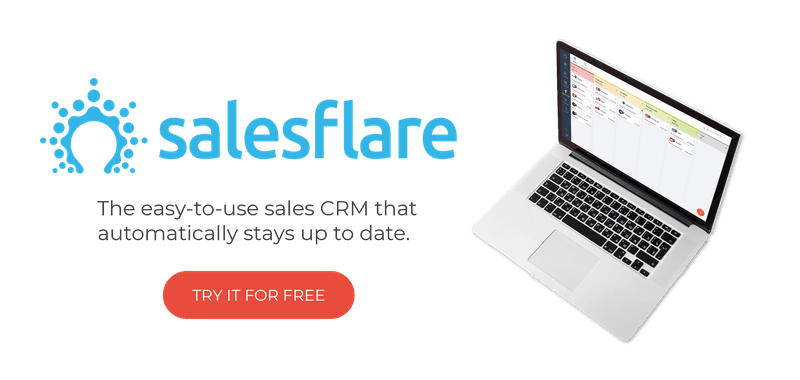
Speriamo che questo post vi sia piaciuto. Se vi è piaciuto, spargete la voce!
👉 Potete seguire @salesflare su Twitter, Facebook e LinkedIn.
- 8 vantaggi del CRM + 6 sfide da superare prima - 18 aprile 2024
- 30+ Migliori strumenti di generazione di lead (per tipo) - 16 aprile 2024
- 7 migliori CRM per Google Workspace + caratteristiche di integrazione - 11 aprile 2024
